Insert a page break
Word automatically inserts a page break at the end of each page when you create a document. You can manually add a page break somewhere else in your document. (You can always delete a page break that you've added but you can't remove one that Word automatically adds at the end of each page.) Also, you can set up rules for Word so the automatic page breaks are placed where you want them. This is especially helpful if you're working in a long document.
You can also use section breaks to control the formatting of your document.
-
Click where you want to start a new page.
-
Click Insert > Page Break.

To see where you've added page breaks, click Home and, in the Paragraph group, click Show/Hide.
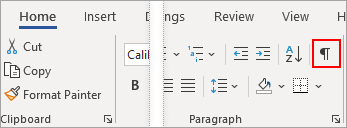
Page breaks look like this:

Adjust automatic page breaks
To prevent automatic page breaks from falling in awkward places, such as between lines of text you'd like to keep together, you can adjust the page break settings for selected paragraphs.
-
Select the paragraphs where you want to apply the settings.
-
Click Layout, and then click the arrow in the Paragraph group.

-
In the Paragraph box, click Line and Page Breaks.
Choose one or more of the following options:
-
Widow/Orphan control places at least two lines of a paragraph at the top or bottom of a page.
-
Keep with next prevents breaks between paragraphs you want to stay together.
-
Keep lines together prevents page breaks in the middle of paragraphs.
-
Page break before adds a page break before a specific paragraph.
-
Start a new page
-
Click where you want to start a new page.
-
Click Insert > PageBreak.

To see exactly where you've added that page break, turn on the non-printing (formatting) characters by clicking Home > Paragraph > Show/Hide.
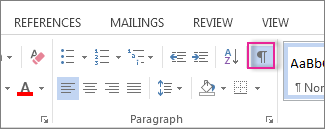
The page break looks like this:

Adding many page breaks to a long document: Precautions
If you're going to add manual page breaks to documents that are several pages long, you may have to change those page breaks later. As you edit your document, you might find that your page breaks in the middle of a paragraph or even between paragraphs that you want kept together.
Or you might have only one line of a paragraph at the top of a page (called a "widow"), or one line of a paragraph all by itself at the bottom of a page (an "orphan").
Do the following to prevent these unwanted page breaks with settings that tell Word where to break or not break a page.
Prevent unwanted page breaks
-
Select the paragraphs you want to apply the settings to.
-
Click Page Layout and then click the arrow in the Paragraph group to open up the Paragraph box.
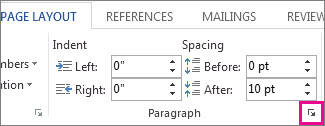
-
Click the Line and Page Breaks tab.
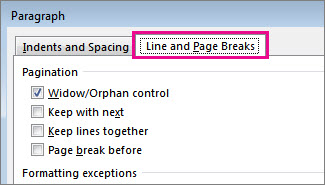
To place at least two lines of a paragraph at the top or bottom of a page Click the Widow/Orphan control box.
Tip: To prevent widows and orphans from happening all the time, make sure that box is always checked.
To prevent breaks between paragraphs you want to keep together Click the Keep with next box.
To prevent a page break in the middle of a paragraph Click the Keep lines together box.
To add a page break before a specific paragraph Click Page break before box.
Insert a manual page break
-
Click where you want to start a new page.
-
On the Insert tab, in the Pages group, click Page Break.
Control where Word places automatic page breaks
If you insert manual page breaks in documents that are more than several pages in length, you might have to change those page breaks as you edit the document. To avoid the difficulty of manually changing page breaks, you can set options to control where Word positions automatic page breaks.
Prevent page breaks in the middle of a paragraph
-
Select the paragraph that you want to prevent from breaking onto two pages.
-
On the Page Layout tab, click the Paragraph Dialog Box Launcher, and then click the Line and Page Breaks tab.
-
Select the Keep lines together check box.
Prevent page breaks between paragraphs
-
Select the paragraphs that you want to keep together on a single page.
-
On the Page Layout tab, click the Paragraph Dialog Box Launcher, and then click the Line and Page Breaks tab.
-
Select the Keep with next check box.
Specify a page break before a paragraph
-
Click the paragraph that you want to follow the page break.
-
On the Page Layout tab, click the Paragraph Dialog Box Launcher, and then click the Line and Page Breaks tab.
-
Select the Page break before check box.
Place at least two lines of a paragraph at the top or bottom of a page
A professional-looking document never ends a page with just one line of a new paragraph or starts a page with only the last line of a paragraph from the previous page. The last line of a paragraph by itself at the top of a page is known as a widow. The first line of a paragraph by itself at the bottom of a page is known as an orphan.
Prevent page breaks in a table row
-
Select the paragraphs in which you want to prevent widows and orphans.
-
On the Page Layout tab, click the Paragraph Dialog Box Launcher, and then click the Line and Page Breaks tab.
-
Select the Widow/Orphan control check box.
Note: This option is turned on by default.
-
Click the row in the table that you don't want to break. Select the entire table if you don't want the table to break across pages.
Note: A table that is larger than the page must break.
-
On the Table Tools tab, click Layout.

-
In the Table group, click Properties.

-
Click the Row tab, and the clear the Allow row to break across pages check box.
You cannot delete the page breaks that Word inserts automatically.
You can delete any page breaks that you insert manually.Delete a page break
-
Click Draft.

-
Select the page break by clicking in the margin next to the dotted line.

-
Press DELETE.
Insert a manual page break
-
Click where you want to start a new page.

-
On the Insert tab, in the Pages group, click Page Break.
Prevent page breaks in the middle of a paragraph
-
Select the paragraph that you want to prevent from breaking onto two pages.
-
On the Page Layout tab, click the Paragraph Dialog Box Launcher, and then click the Line and Page Breaks tab.
-
Select the Keep lines together check box.
Prevent page breaks between paragraphs
-
Select the paragraphs that you want to keep together on a single page.
-
On the Page Layout tab, click the Paragraph Dialog Box Launcher, and then click the Line and Page Breaks tab.
-
Select the Keep with next check box.
Specify a page break before a paragraph
-
Click the paragraph that you want to follow the page break.
-
On the Page Layout tab, click the Paragraph Dialog Box Launcher, and then click the Line and Page Breaks tab.
-
Select the Page break before check box.
A professional-looking document never ends a page with just one line of a new paragraph or begins a page with only the last line of a paragraph from the previous page. The last line of a paragraph by itself at the top of a page is known as a widow. The first line of a paragraph by itself at the bottom of a page is known as an orphan.
-
Select the paragraphs in which you want to prevent widows and orphans.
-
On the Page Layout tab, click the Paragraph Dialog Box Launcher, and then click the Line and Page Breaks tab.
-
Select the Widow/Orphan control check box.
Note: This option is turned on by default.
Prevent page breaks in a table row
-
Click the row in the table that you don't want to break. Select the entire table if you don't want the table to break across pages.
Note: A table that is larger than the page must break.
-
On the Table Tools tab, click Layout

-
In the Table group, click Properties

-
Click the Row tab, and the clear the Allow row to break across pages check box.
Manually add a page break anywhere in your document:
-
If you're not in Editing View, click Edit Document > Edit in Word Online.
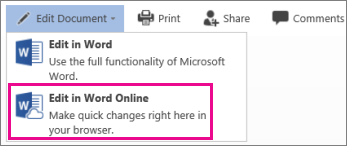
-
Place your cursor where you want to start a new page.
-
Choose Insert > Page Break.
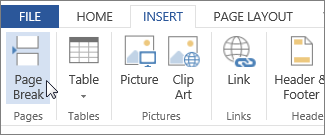
While in Editing View, the manual page break will look like this:

You won't see this in Reading View. In Reading View, manual page breaks show up as gaps between pages, just like automatic page breaks.
Tip: To quickly insert a page break using your keyboard, type Ctrl+Enter.
No comments:
Post a Comment